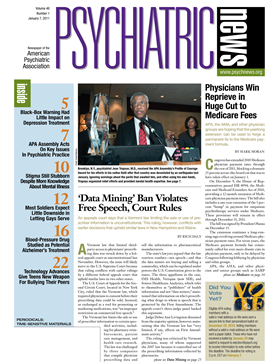Young people were significantly less likely to receive a prescription for antidepressant medication following the FDA's March 2004 “black-box” warning about a risk of suicidality associated with antidepressant use in youth, according to a retrospective analysis of claims data for privately insured children and adolescents.
But when youth with the diagnosis of depression were separated into those with major depressive disorder (MDD) and those with less severe depression diagnoses, only the latter had a significant postwarning antidepressant-use decline, according to the study.
Also revealed by the study was a significant increase in the use of psychotherapy without medication among children and adolescents with depression after the black-box warning was issued. The study was published in the November 2010 Medical Care.
The report appears to suggest that the FDA warning about a risk of suicidality related to use of antidepressants in some children and adolescents served its purpose of producing greater caution about use of antidepressants in less severely ill patients. At the same time, it seems that the warning did not negatively affect the likelihood of those patients being seen by a clinician, since the rates of psychotherapy without medication increased in the postwarning period.
“One of the concerns when the black-box warning first appeared was that it would have a broad and indiscriminately chilling effect on the prescription of antidepressants for young people and that children and adolescents who needed antidepressant treatment would not receive it,”
Marc Olfson, M.D., M.P.H., told Psychiatric News. “The current study is reassuring in the sense that it provides some context showing that the response was in fact clinically nuanced, involving reductions in antidepressant use for young people with less severe depression that was relatively modest in scope.”
Olfson is a health services researcher and professor of clinical psychiatry at Columbia University College of Physicians and Surgeons who authored an editorial in Medical Care accompanying the study.
“The other concern was that the warning would keep people from treatment altogether,” Olfson said. “But on the basis of the results of this study, it doesn't seem to have been the case, because there was a significant increase in psychotherapy in the wake of the black-box warning.”
In the study, data on antidepressant prescribing and psychotherapy were examined for 40,309 youth aged 2 to 17 with a new-onset depression diagnosis, of whom 11,532 had a diagnosis of MDD. Data were analyzed from July 2003 through December 2006 and divided into two periods: the “prewarning period” from July 2003 to February 2004, and the “postwarning period” from March 2004 to December 2006.
The study population was derived from U.S. commercial administrative claims within the i3 INNOVUS database, which contains demographic and enrollment data, inpatient and outpatient claims, and pharmacy claims data for the 16 million lives covered by a large managed health care plan offering behavioral health services.
Results showed that for the total cohort of 40,309, the likelihood of an antidepressant being dispensed was significantly lower in the postwarning period for both children and adolescents, with an adjusted odds ratio of 0.85. And for children and adolescents with non-MDD diagnoses (28,777), the likelihood of being prescribed an antidepressant was even lower.
But for the 11,532 youth with MDD, the likelihood of an antidepressant being dispensed following the warning did not significantly differ between the before and after period for either children or adolescents.
Meanwhile, the likelihood of receiving psychotherapy in the postwarning period was greater for children and adolescents with both MDD and non-MDD depression diagnoses.
The uptick in psychotherapy would appear to neatly mirror, in reverse, the decrease in prescribing. Olfson noted that following the FDA warning, there was a decrease from 42 percent to 35 percent in youth receiving antidepressants within 180 days of a new depression diagnosis; this decline was offset by an increase from 37 percent to 44 percent in the percentage of new depression episodes in which treatment included psychotherapy without antidepressant medications.
“The current study expands our existing understanding in several areas,” said child psychiatrist and APA treasurer David Fassler, M.D. “Based on a retrospective analysis of claims data, the authors demonstrate that there was no change in the use of antidepressants in pediatric patients who had an actual diagnosis of major depressive disorder, suggesting that the reduction was limited to children and adolescents with less-severe symptoms. In addition, the authors reported an increase in referrals for psychotherapy across all depression-related diagnoses and age groups.”
But Fassler noted methodological issues that limit the interpretation of the findings. “For example, there are no data on who made the diagnoses or whether or not they were accurate,” he said. “Nor is there information on the type of psychotherapy children received, and whether or not they responded to treatment.
“The authors also don't present data on other medications that may have been prescribed. Several reports have suggested that the decrease in the use of SSRI antidepressants was accompanied by an increase in the use of atypical antipsychotic medication. Despite these limitations, the results represent a contribution to our evolving understanding of the public-health consequences of regulatory decisions.”
Olfson agreed that claims data lack the kind of clinical detail necessary to unravel what he called a “nettlesome and difficult issue”—that of the supposed risk of suicidality associated with antidepressant treatment in young people.
He acknowledged that there is “still a fair amount of contention and controversy within the field.” But he said that he believes the strongest evidence supports “a small and incremental increase in risk of suicidal behavior with antidepressant treatment in young people.”
Olfson added, “The question is how to balance that risk against the evidence demonstrating improvement associated with treatment of depression. The real challenge is to try to identify subgroups of young people who may be particularly sensitive to what is a rare but potentially serious adverse effect.”
